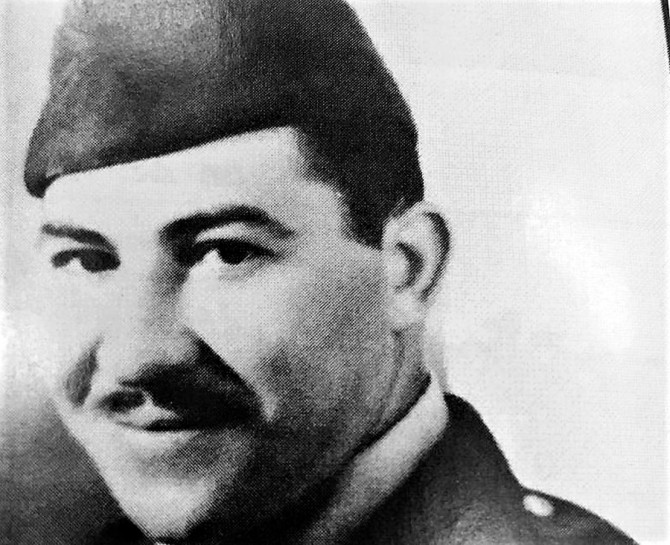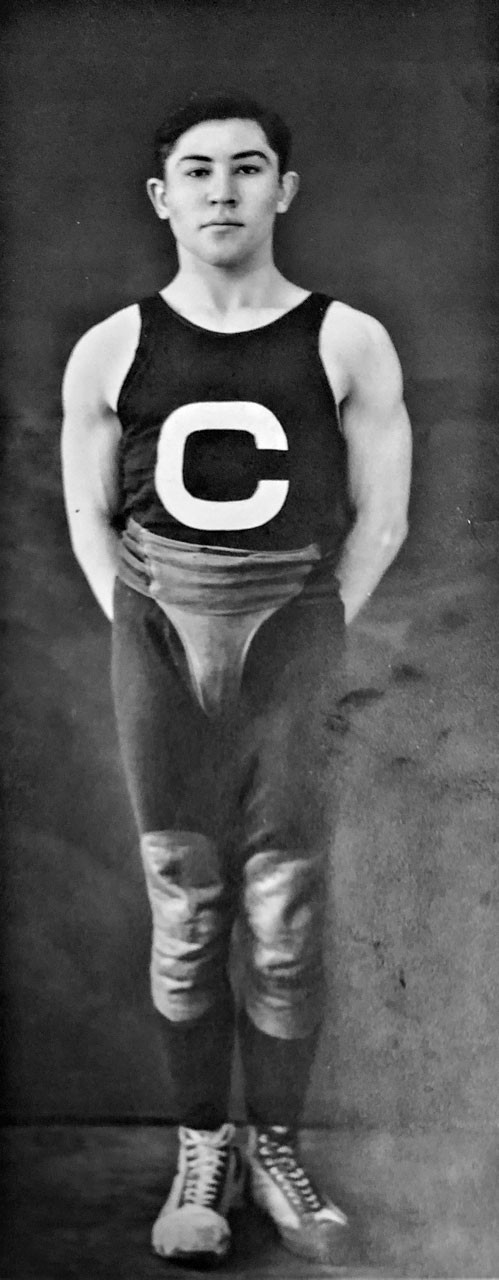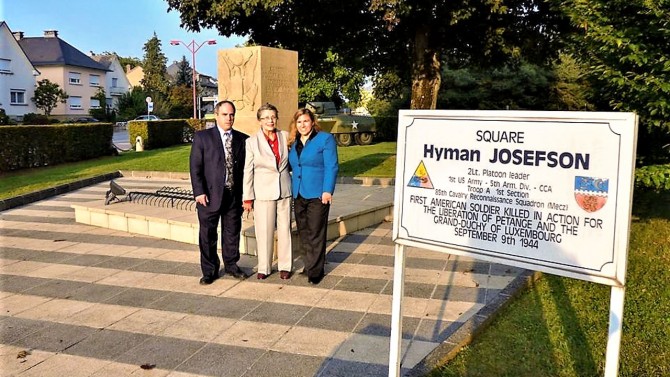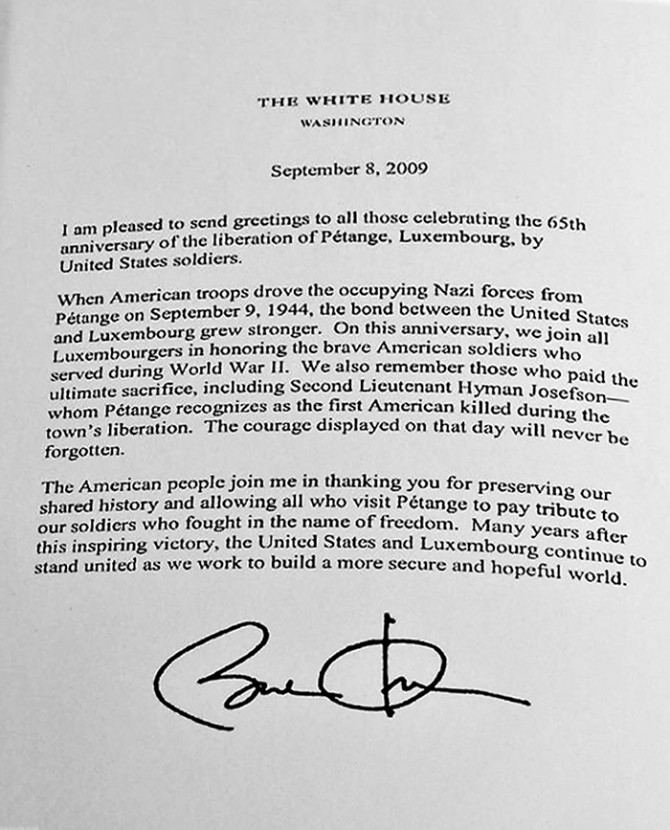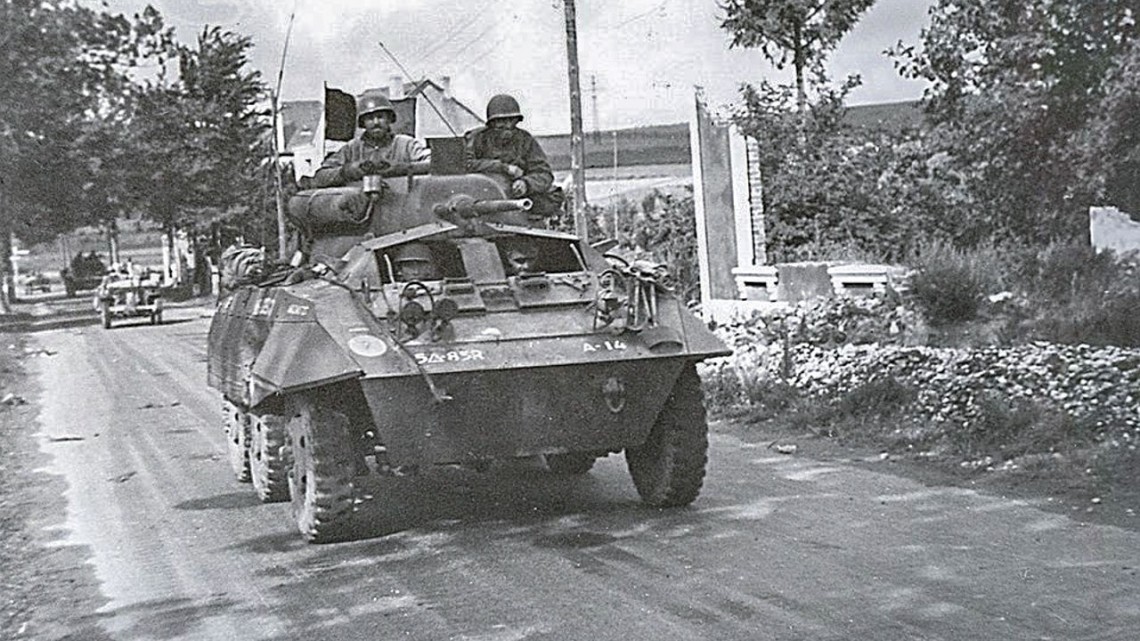
Hyman Josefson, top left, in his M8 Greyhound armored vehicle as it passes through the streets of Petange, Luxembourg, on Sept. 9, 1944. Shortly after this picture was taken, the vehicle was struck by German cannon fire and burst into flames. Josefson died in the attack, but his three comrades survived.
Alum, WWII hero to be celebrated on Memorial Day
By Deborah Josefson
Nearly 4,000 miles separate Cornell’s campus in Ithaca, New York, from Petange, Luxembourg, yet they are linked through the achievements and wartime exploits of a World War II soldier, 2nd Lt. Hyman Josefson ’29, J.D. ’31.
Once the “unknown soldier,” Josefson is venerated in Petange as a symbol of the heroism and sacrifice of all American soldiers, and recognized as the first U.S. soldier to die for the liberation of Luxembourg.
In 1947 a monument was erected in his honor, and in 1989 the land on which the monument sits was named Square Hyman Josefson. This year marks the 75th anniversary of the end of World War II, and Ancestry.com and The History Channel will feature Josefson’s story May 25 in their Memorial Day Virtual Parade of Heroes.
Josefson entered Cornell on a full scholarship at the age of 15, having attained the highest score on the New York state scholarship exam. A first-generation American, Josefson was born in 1909 in Middletown, New York, the youngest son of Herschel and Lena Josefson, Romanian Jewish immigrants.
As a youngster, Josefson was a newspaper boy, athlete and Eagle Scout. Like his older brother, Abraham ’22, Josefson entered Cornell on state scholarships and majored in engineering in the College of Arts and Sciences. He joined the wrestling team and excelled both on and off the mat, with elections to Phi Beta Kappa and Sphinx Head.
Josefson dominated the bantam weight class in intercollegiate wrestling, winning NCAA and Eastern championships in 1928 and ’29.
After earning his law degree at Cornell in 1931, he became an accomplished attorney and engineer, but at age 32, just six weeks after the attack on Pearl Harbor, he joined the U.S. Army. Josefson was one of 550,000 Jewish American soldiers whose service in World War II was weighted with both patriotism and the knowledge that they were fighting against Hitler for the survival of their European brethren. Assigned to the 5th Armored Division’s 85th Cavalry Reconnaissance Squadron, Josefson was sent overseas.
His unit landed at Utah Beach on July 24, 1944, marched through Normandy and Northern France, reaching Paris on Aug. 30 and Belgium three days later.
As a platoon leader and car commander of the 85th Cavalry Reconnaissance Squadron, Josefson was an advance man – the eyes and ears of the Army. The M8 Greyhound vehicle he commanded was thinly armored, agile on good roads but notorious for breakdowns in the forests and muddy environments he encountered. Despite these limitations, Hyman and his comrades pushed on, buoyed by the crowds as they passed through Metz, France and Athus, Belgium.
Meanwhile, Luxembourg’s Prince Felix and Duke Jean, previously in exile, attached themselves to the 5th Armored Division, gearing up for a return home.
By midday Sept. 9, 1944, Josefson’s M8 patrol car was the first to breach the Belgian border and enter Petange, Luxembourg. But it was quickly met by a shell fired from a hidden German cannon, and the M8 burst into flames.
Josefson was unable to escape the burning vehicle, although the three soldiers serving with him did, with injuries. A crowd witnessed the attack and erected a makeshift memorial near where Josefson was killed.
Subsequently, the Americans advanced and liberated Luxembourg City on Sept. 10, returning Prince Felix and Duke Jean to the capital.
For 45 years, Josefson’s identity remained unknown. But in the late 1980s, when battle site tours became popular, gunner Cyril Mayrose passed the Unknown Soldier monument created by Claus Cito in 1947. Mayrose disclosed that the felled soldier was his car commander, Hyman Josefson.
In 1989, Square Hyman Josefson was dedicated. The square has been augmented over the years with the addition of a replica M8 Greyhound and interpretive plaques. A new museum about the liberation opened last year, across from the square, and features footage of Josefson in his M8 passing through Belgium, on fire.
Over the years, Square Hyman Josefson has become an integral part of Luxembourg’s liberation celebrations, a site of pilgrimage for veterans and a focal point for U.S.-Luxembourg relations. Josefson’s ultimate sacrifice even merited a mention in President Barack Obama’s 2009 letter of greeting to the people of Petange.
Every five years, Square Hyman Josefson is visited by the Duke of Luxembourg, the U.S. ambassador and other dignitaries who lay wreaths at the site and pay tribute to Josefson and other U.S. soldiers – young men who left the comfort of their homes and died fighting for the freedom of strangers an ocean away.
Dr. Deborah Josefson is the great-niece of Hyman Josefson; she traveled to Luxembourg for the 75th anniversary of its liberation from the Nazis and for Josefson’s memorial ceremony.
Media Contact
Get Cornell news delivered right to your inbox.
Subscribe